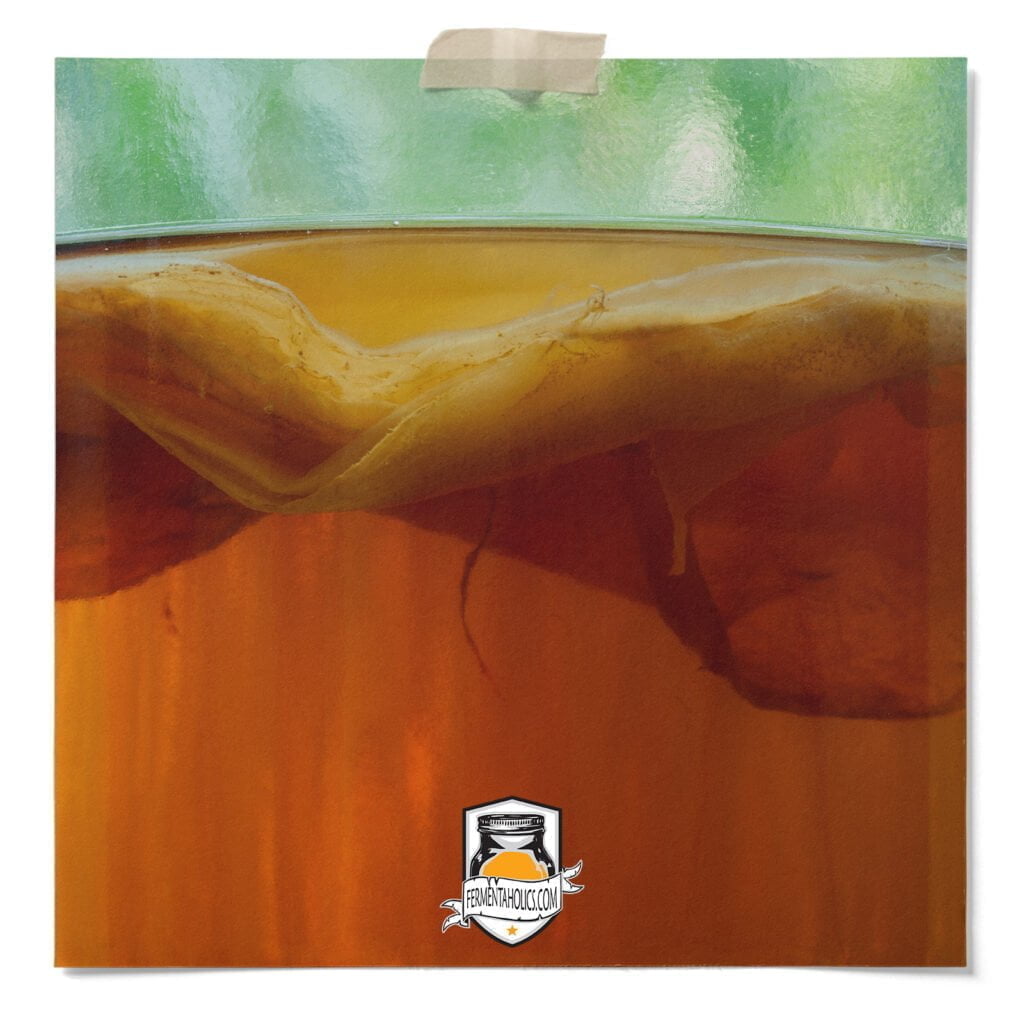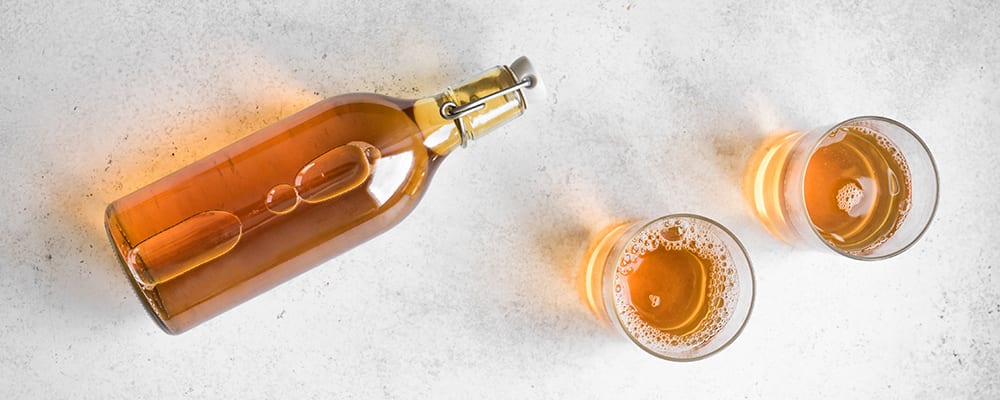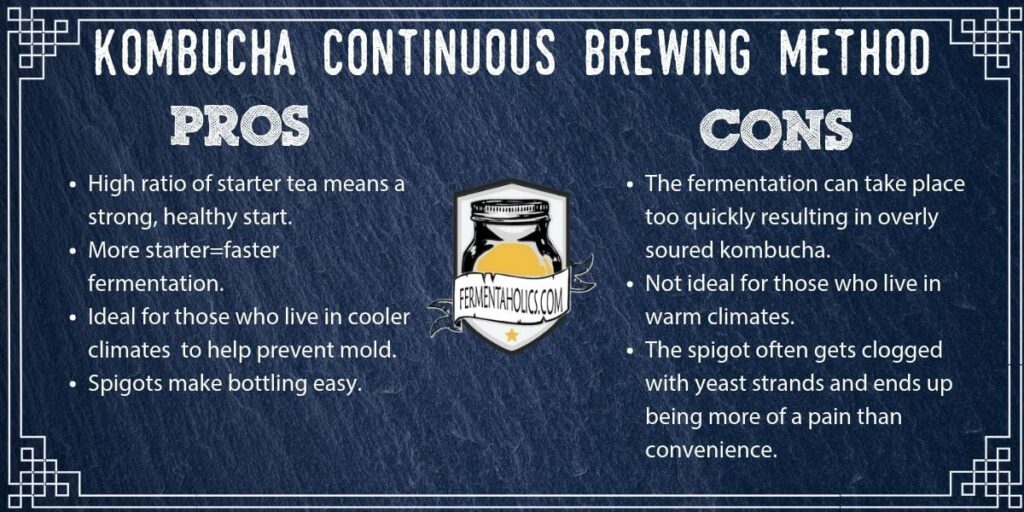
After deciding that you’re going to brew your own kombucha, next comes the research phase. What kind of brewing vessel should you use, how do you brew kombucha, what kind of tea or sugar to use, should you use the continuous brew method or the batch brewing method? While it seems like there is a lot to figure out and decide, it doesn’t need to be too complicated. In this post I’m going to dissect the continuous brewing method to hopefully help simplify this part of the process.

Continuous brewing is a popular brewing style among home brewers where you continuously draw off kombucha from the brew vessel and replenish it with fresh sweet tea as needed in a continuous fashion. It is typically done in larger vessels with a spigot so it can remain in place. It is praised as a lower maintenance way to always have fresh kombucha on tap.
Batch brewing. It is named after the idea that you begin a fresh new batch with each brew (as opposed to drawing off a certain amount and replenishing it often). For batch brewing, you reserve 1-2 cups starter from a finished batch of kombucha, then transfer it to a new freshly brewed gallon of sweet tea and let it ferment.

Honestly, not all that much. There’s a lot of information out there advising that one method is better than the other when the reality is they’re kind of the same thing.
The biggest difference between continuous brewing and batch brewing is the ratio of starter tea to sweet tea with each batch. For me, this isn’t enough to call it a different method, rather more like a different recipe.
With continuous brewing, it is advised to keep about 30% kombucha in the vessel as your starter tea, as opposed to 10% for the batch method.
When brewing with a higher percentage of starter tea, it generally brews faster and starts off with a lower pH. If you live in colder climates, using more starter tea is a great way to help protect your kombucha from mold. If you live in a warmer climate, you might want to stick with less starter so that you kombucha doesn’t ferment faster than you want it to.
Continuous brewing vessels tend to be at least 2 gallons, and equipped with a spigot. As the brewing vessels get larger, it becomes more difficult to move and handle the vessel, so they often sit on a stand with a spigot for easy bottling. Many different vessel options are available glass, ceramic or stainless steel (See this article for information on using metal with kombucha).
Can you use this same vessel for batch brewing? Yes. Even if you’re using it for continuous brewing, the only difference is the ratio of starter tea that you’re using.
There are three things to consider when choosing a method.

Kombucha Continuous Brewing Method – Pros vs Cons
For batch method, the recipe is set (1 cup sugar, 2 tbsp tea, 1.5 cups starter tea), but what about for continuous brewing? How do you know how much sugar or tea to add?
You basically want to replace the amount of liquid that you removed with sweet tea. So if you have a 2-gallon crock and bottle your kombucha, leaving 30% starter in the crock, that leaves you with about 1.37 gallons to brew and fill it up.
You can make it easier and do 1.25 gallons, leaving a little room at the top. The ratios are relatively flexible, so don’t worry too much about getting it perfect. With time, you’ll get used to the process and figure out what works best for you.
To make the brewing process go faster, you can brew a tea concentrate and dilute it with cool water. This will bring the temperature down to a safe level before adding it to your crock.
To brew 1.25 gallons of sweet tea:
-Bring about 4 cups of water to a boil.
-Steep 2.5 tbsp of tea or 8 tea bags for 10 minutes
-Stir in 1.25 cups of sugar
-Dilute with 1 gallon of cool water. You’ll want the tea to be below 85F before adding it to your brewing vessel with your starter tea.
-Carefully pour the tea into the vessel, cover, and let ferment.
-Begin tasting in about 7 days to test how the progression is going.
See this post for complete instructions on how to make kombucha. This goes over the batch method. But as I described earlier, they are really the same thing, except one has more starter tea.

Continuous brew kombucha is a method of brewing kombucha which involves keeping a constant, ongoing batch of tea in fermentation. Rather than completely emptying the fermentation vessel after each batch, a portion of the fermented tea is left as a starter for the next brew.
Continuous brewing offers several benefits over batch brewing. It provides a constant supply of kombucha, and can reduce the risk of contamination due to less handling, saves time as it requires less cleaning and resetting.
To set up a continuous brew system, you need a brew vessel with a spigot, a kombucha SCOBY, and starter liquid. Fill your brew vessel with sweet tea, then add the SCOBY and starter liquid. Cover the vessel with a cloth and secure with a band. Allow it to ferment at room temperature, away from direct sunlight.
You can begin drawing kombucha from a continuous brew system once it has reached your desired level of sweetness and sourness, typically between 7-21 days. Taste the brew every few days using a straw to check the fermentation process.
To maintain a healthy continuous brew system, ensure that you replenish the system with fresh sweet tea after you draw off your desired amount of kombucha. This keeps the SCOBY nourished and the brewing process active. It is also recommended to periodically clean the spigot and vessel to prevent build-up and potential contamination.
Generally, you can draw off up to 90% of the kombucha from your vessel at a time, leaving at least 10% in the vessel. This remaining liquid acts as the starter for your next batch of sweet tea.
The recommended temperature for brewing kombucha is between 75-85 degrees Fahrenheit (24-29 degrees Celsius). Temperatures below this range can slow the fermentation, while temperatures above can speed it up.
SCOBY (Symbiotic Culture Of Bacteria and Yeast) is essential in the brewing process. It consumes the sugar in the sweet tea and produces various acids, alcohol, and carbon dioxide, transforming the tea into kombucha with its unique flavor and health benefits.
You should add fresh sweet tea to your continuous brew system each time you draw off kombucha. This helps to maintain the health of the SCOBY and the continuity of the fermentation process.
The key ingredients needed to brew kombucha in a continuous brew system include a SCOBY, starter liquid (previously fermented kombucha), sweet tea made from sugar and black or green tea, and a brewing vessel with a spigot.
Yes, it is important to use a cloth cover for the brew vessel. This allows the brew to breathe while fermenting and helps to prevent fruit flies and other contaminants from getting into the kombucha.
We always recommend using black or green tea for primary kombucha fermentation.
It’s important to leave some kombucha in the vessel after drawing off because this fermented tea acts as a starter for the next batch, providing a conducive environment for the SCOBY to ferment the newly added sweet tea.


Looks like you haven't made a choice yet.